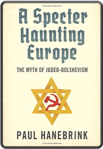 Paul Hanebrink is Associate Professor of History at Rutgers University. In his new book, A Specter Haunting Europe: The Myth of Judeo-Bolshevism, Hanebrink traces the violent history of European anti-Semitism from the Russian Revolution to the present. Because some Communists were Jews, many across Europe took for granted that Jews were Communists, identifying the entire population as a threat to established order.
Paul Hanebrink is Associate Professor of History at Rutgers University. In his new book, A Specter Haunting Europe: The Myth of Judeo-Bolshevism, Hanebrink traces the violent history of European anti-Semitism from the Russian Revolution to the present. Because some Communists were Jews, many across Europe took for granted that Jews were Communists, identifying the entire population as a threat to established order.
ECM: Much of your work traces the history of anti-Semitism, and you’re doing that work at a time when anti-Semitism seems to be resurgent once again. How do you situate this political moment within that larger history?
PH: That’s an interesting question. Conspiracy theories flourish in times of political and social turmoil. The Judeo-Bolshevik myth was born amid a general crisis in Europe at the end of World War I that saw revolutions, labor unrest, and in places civil wars. For many people, it seemed a way to explain the breakdown in social and cultural order and the threats that a global ideological force posed to national sovereignty. Of course, the political instability in Europe and here in the United States today is nothing like that earlier crisis in terms of levels of violence.
Nevertheless, the nationalist Right in many countries is again talking about the erosion of traditional cultural norms and the fragility of national sovereignty in the face of global forces. As they do, certain anti-Semitic tropes are returning to public discourse. I first began tracking these questions in post-1989 Eastern Europe, where they expressed dissatisfaction with the way that communism had ended, and with the way that a new liberal democratic order had arisen, which many of them understood as anti-national and global in scope. In recent years, I’ve really been struck by how these issues have become a continent-wide and even an American concern.
ECM: You suggest that much of this is traceable to the “Myth of Judeo-Bolshevism” in twentieth century Europe. What do you mean by that?
PH: At one level, the myth of Judeo-Bolshevism is an updating of older myths of worldwide Jewish conspiracy, which you can find in the middle ages or in the nineteenth century. The Judeo-Bolshevik myth adapted these older paranoid fantasies to the ideological climate of the twentieth century. In this form, the Judeo-Bolshevik myth asserts that Jews as a population were uniquely responsible, not just for creating Communism as an ideology, but for perpetrating its crimes. In the twentieth century, the myth of Judeo-Bolshevism became a template for focusing more general fears of Communism, revolutionary unrest, or any dangerous ideas onto Jews as a group. The fact that some Communists were Jews (or came from Jewish families) helped to make this idea plausible for many people.
ECM: To what extent did this idea motivate Nazi anti-Semitism?
PH: It was definitely an important factor. The opportunity to attack Judeo-Bolshevism is very important to Adolf Hitler in his early career, but at the same time, I don’t want to suggest that communism caused his anti-Semitism. It had many different facets. But the association of Jews with communism was very central to Nazism from very early on and remained so until the very last days. And it was also one of the aspects of Nazi anti-Semitism that had the most popular resonance and support. You could find it in Christian circles—both Catholic and Protestant—among people who had other doubts about aspects of the Nazi regime but could believe that this was a threat to Germany and were quite thankful to the Nazis for protecting them from it. And when Nazi Germany went to war against the Soviet Union in 1941, the idea—spread by Joseph Goebbels’ propaganda office—that the invasion was a crusade to defend Germany and all Europe against the Judeo-Bolshevik menace in the East, was widely popular, both in Germany and abroad—at least, as long as the Germans seemed to be winning the war.
ECM: After World War II, as Communism spread across Eastern Europe, it carried the widespread fear that Jews were intent, not just on implementing Communism, but on taking revenge against their enemies. To what degree did this fear drive post-war anti-Semitism?
PH: I think that’s one of the most important driving forces behind the pogroms that you see in Poland in 1946. The other kinds of anti-Semitic violence and persecution that you see in other countries at this time can be linked to the idea that the Jews who had survived the Holocaust were going to come back and use Soviet occupation to take revenge on the societies around them. Scapegoating Jews for Communism was one way to make sense of the very real fears of what Soviet occupation and Communist rule would mean.
It also reflected how astonished many people were that Jews were visible again after the war years, during which they had been stripped of their rights, forced out of the public eye and often into hiding, and deported to camps. Many people connected these two things in their minds as a way of interpreting what was a very turbulent time in the history of the region.
You can see this, for example, in all of the real anger and fear that was directed against the criminal proceedings against fascist collaborators in Eastern Europe. Those courts were largely dismissed in popular media as being “Jewish courts.” You could also see it in the ways that many people across Eastern Europe picked out specific individuals in the communist regimes, noted their Jewish ancestry, and then implicated them in a larger conspiracy perpetrated by all Jews.
Read the whole thing at Religion Dispatches.
